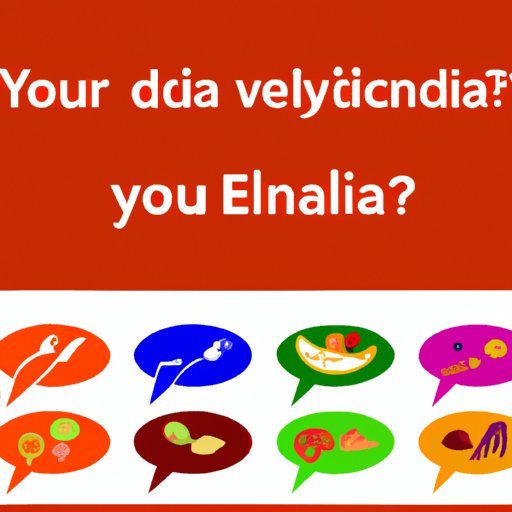
Introduction
Food is the universal language of love and care. It has the power to bring people together and break down cultural and communication barriers. When you are traveling to a Spanish-speaking country, “Did you eat?” is one of the most common questions you will come across. It’s a simple, friendly inquiry, but there’s more to it than just stating a basic necessity. In this article, we will explore the meaning, cultural significance, and variations of “Did You Eat?” in Spanish-speaking countries.
¿Comiste ya?
One of the most common questions you will hear in Spanish-speaking countries is “¿Comiste ya?” which literally translates to “Did you eat already?” or “Have you eaten?” This question is the most straightforward way to offer hospitality and show care. Whenever someone asks you, “¿Comiste ya?” it is a friendly way to show interest in your well-being and demonstrate the importance of food in the culture. You may hear the same question posed in slightly different ways, such as “¿Comiste?” or “¿Ya comiste?” but the meaning remains the same.
Food & Culture in Spanish-speaking Countries
Food is a significant part of the culture of Spanish-speaking countries. Spaniards and Latin Americans in general consider food as more than just a means of satisfying hunger; it’s a reason to gather, celebrate, and come together as a family. In Spain, for example, lunch (La Comida) is the biggest meal of the day and typically lasts two hours or more. In Mexico, meals are seen as symbolic because of the close connection between food and the state’s geography. In Cuba, food is a symbol of the bond between the Afro-American and Hispanic cultures founded in this island’s history. As you can see, food forms a rich tapestry of the region’s history, geography, and social customs.
The custom of gathering around food has a long history. Families and friends gather around the table for major events such as wedding celebrations, baptisms, and birthdays. Sharing a meal brings people together and builds strong bonds of loyalty and trust. “Did you eat?” is not only about asking a question but also about communicating that sharing food is a priority in the culture.
From “¿Comiste?” to “¿Ya comiste?”
As previously mentioned, “¿Comiste ya?” is the most common phrase used to ask if someone has eaten in Spanish-speaking countries. Here are some other variations:
- “¿Comiste?” (Did you eat?)
- “¿Ya comiste?” (Did you eat already?)
- “¿Has comido?” (Have you eaten?)
- “¿Tienes hambre?” (Are you hungry?)
- “¿Qué has comido?” (What did you eat?)
Each phrase’s usage depends on the context and the level of familiarity between the speaker and the listener. For instance, “¿Qué has comido?” is more commonly used among friends catching up at the restaurant than in a formal setting.
Tips on How to Answer “Did You Eat?” in Spanish
If you’re a beginner in Spanish and you want to learn how to respond to the question “Did you eat?” here are some common responses that can be helpful:
- “Sí, comí” (Yes, I ate)
- “No, aún no he comido” (No, I haven’t eaten yet)
- “Estoy lleno/a” (I’m full)
- “Gracias, ya comí” (Thanks, I already ate)
- “No, no tengo hambre” (No, I’m not hungry)
Learning Spanish through Food
One of the best ways to learn Spanish and immerse yourself in the culture is by exploring food. Food-related conversation starters are a great tool to strike up conversation and practice your Spanish skills. Here are some phrases you may use:
- “¿Qué me recomiendas?” (What do you recommend?)
- “¿Qué es esto?” (What is this?)
- “Me encanta la comida de aquí” (I love the food here)
- “¿Cómo se prepara?” (How is it made?)
- “Esto sabe muy bien” (This tastes really good)
These phrases can act as conversation starters, and locals will appreciate your efforts to connect to their culture.
Beyond “¿Comiste?”
While “¿Comiste ya?” is the mostcommon question to ask someone whether they’ve eaten or not, there are a few other options. Here are a few:
- “¿Has desayunado?” (Have you breakfasted?)
- “¿Has almorzado?” (Have you lunched?)
- “¿Has cenado?” (Have you dined?”)
These questions ask about specific meals rather than just a general question on whether you have eaten or not. Use these phrases in situations where you want a more detailed answer about the day’s meals.
A Brief History of “Did You Eat?” in Spanish
The history of the phrase “Did you eat?” dates back to ancient Rome. During that time, people would use the phrase “Meditaris non potes”- which translates to “You can’t think if you are not well-fed.” This phrase highlights the importance of nourishment not just for the body but also for the mind.
As Latin was the language of Rome and many other countries in Europe for centuries, It’s not surprising that the Romans’ words made it into Spanish. European expansion also helped spread food-related phrases around the world, making “Did you eat?” commonplace in many countries.
Conclusion
The phrase “Did You Eat in Spanish?” explores how the question communicates not only an essential need but a part of the larger culture. When you ask someone, “¿Comiste ya?” you show interest in their well-being and a shared acknowledgment that food is a crucial aspect of life. By learning and practicing these food-related phrases in Spanish, we enter into a culture that is rich and flavorful-filled not only with welcoming people but fantastic food.
Final thought: Next time you travel to a Spanish-speaking country, make it your mission to strike up a conversation using a food-related question. You will reap the rewards of cultural exchange and expand your world.





